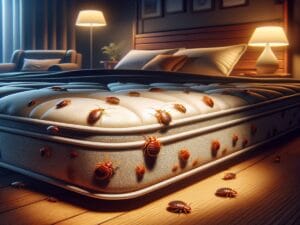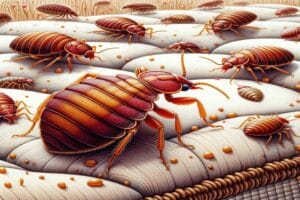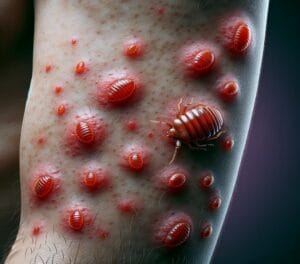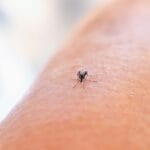Key Takeaways: Essential Bed Bug Knowledge
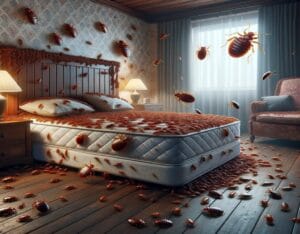
- Identify bed bugs by their small, flat, oval-shaped bodies and reddish-brown color.
- Look for signs of bed bugs such as rusty stains, dark spots, and shed exoskeletons on bedding and furniture.
- Understand that bed bug bites can mimic other insect bites, but typically appear as red, itchy welts in a line or cluster.
- Early detection and professional treatment are critical for effective bed bug eradication.
- Prevent bed bug infestations by inspecting second-hand items, using protective covers, and maintaining cleanliness.
Know Your Enemy: The Bed Bug
Bed bugs are sneaky little critters, infamous for their hitchhiking abilities and their preference for human blood. But before we dive into how to spot them, let’s get to know these pests a bit better. Adult bed bugs are about the size of an apple seed, have flat, oval-shaped bodies, and boast a rusty reddish-brown color. They’re masters of hide and seek, tucking themselves away in the tiniest of crevices during the day and emerging at night to feed.
Defining Characteristics of Bed Bugs
When trying to identify a bed bug, look for these features:
- A small, flat, oval-shaped body without wings.
- A size that can range from 1mm (nymphs) to 5mm (adults).
- A color that varies from nearly white (just after molting) to a deep brown or burnt orange.
- Six legs and two antennae, which are shorter than their body.
- Their ability to swell and turn a reddish color after feeding on blood.
Remember, these pests don’t just pop up out of nowhere. They’re usually brought into your home unknowingly through luggage, clothing, used furniture, or other items that have been in infested areas.
A Day In the Life: Bed Bug Behavior
Bed bugs are mostly nocturnal, which means they come out to feed on your blood primarily at night. During the day, they hide in a variety of places close to where people sleep. These can include mattresses, box springs, bed frames, and headboards. However, don’t be fooled by their name; bed bugs can also be found behind wallpaper, in the seams of chairs and couches, in drawers, and even in electrical appliances!
One important thing to know is that bed bugs can survive for several months without feeding, so just because you haven’t been bitten for a while doesn’t mean they’re gone. They’re patient and will wait for their next meal—unfortunately, that’s you.
Signs of Stealthy Invaders
Now, let’s talk about how to spot these unwelcome guests. Bed bugs are experts at remaining hidden, so it’s crucial to know the signs of an infestation.
Rusty Stains and Tiny Shells: Evidence on Linens
If you’re waking up with itchy spots you didn’t have when you went to sleep, it’s time to do a thorough check. Here’s what you should look for:
- Rusty or reddish stains on your sheets or mattresses caused by crushed bed bugs.
- Tiny, pale yellow skins that nymphs shed as they grow larger.
- Tiny, dark brown or black fecal spots that might bleed on the fabric like a marker would.
These signs are often found in the corners and seams of your bedding, but also check around the bed frame and headboard.
Unwelcome Artwork: Fecal Spots on Surfaces
Bed bugs leave behind more than just physical evidence on linens. They also deposit fecal spots on surfaces where they hide. These spots are smaller than a pinhead and may look like tiny ink dots. Check for these telltale signs on walls, furniture, and even your clothing. Because bed bugs tend to live in groups, finding one of these signs usually means there are more nearby.
Keep in mind, though, that these signs can be easy to overlook or mistake for other household stains or bits of debris. That’s why it’s essential to be meticulous and proactive when inspecting your space.
Bed Bug Bites vs. Common Misconceptions
It’s a common mistake to think that all itchy bites in the morning are from bed bugs. However, many insects like mosquitoes, fleas, and ticks can leave similar marks. Bed bug bites usually have a distinct pattern—they often appear in a line or cluster, as these pests tend to feed multiple times in one outing. The bites themselves are red, swollen, and very itchy. If you notice bites that fit this description, especially after sleeping, it’s a good indicator of bed bugs.
But, remember, not everyone reacts to bed bug bites, which means you could have an infestation without any bite marks. Therefore, it’s crucial to look for other signs of bed bugs to confirm their presence.
Also, it’s worth noting that bed bugs don’t transmit diseases through their bites. While the bites can be annoying and cause discomfort, they are not considered a medical threat. But, the psychological toll and the disruption of your peace of mind? That’s another story entirely.
When to Seek More Than a Band-Aid Solution
When you’ve got a few bites and you’ve spotted a bed bug or two, it might be tempting to try some DIY fixes. However, if your efforts are not thorough, they could lead to a full-blown infestation. It’s time to call in the pros when:
- You consistently find bed bugs or signs of them after initial treatments.
- The number of bites you’re getting is increasing.
- You’re dealing with anxiety and stress due to the infestation.
Professional exterminators have the knowledge, experience, and tools to tackle bed bug problems effectively. They’ll provide a comprehensive approach that includes not just treatment but also education on how to prevent future infestations.
Declaring War: Treatment Options
If you’ve discovered bed bugs in your home, it’s time to take action. There are several methods for treating bed bugs, ranging from DIY solutions to professional services. The best approach will depend on the severity of the infestation, your budget, and your personal preferences.

At-home treatments can include thoroughly washing and heat-drying bed linens, curtains, and clothing. You can also use bed bug-proof mattress encasements to trap any bugs living inside your mattress or box spring. Vacuuming regularly and using bed bug sprays can help, but these methods may not reach the hidden bugs or eggs.
For a more robust approach, professional exterminators can use a combination of chemical and non-chemical treatments. They may employ heat treatments, which involve raising the temperature in your home to a level that is lethal to bed bugs. Chemical treatments can include the use of insecticides specifically designed to kill bed bugs at all stages of their life cycle.
Example: Jane, a homeowner, noticed a line of bites on her arm and small blood stains on her sheets. After a quick inspection, she found shed skins near her bed frame. Realizing the gravity of the situation, she immediately contacted a professional pest control service that implemented a heat treatment and followed up with chemical sprays. Within a few weeks, her home was bed bug-free.
Starting Your Offensive: Initial Steps
The moment you suspect bed bugs, start with some initial steps to curb their spread:
- Strip your bed and wash all linens, curtains, and clothing in hot water, then dry them on the highest dryer setting.
- Vacuum your bed, bed frame, and surrounding areas thoroughly. Immediately dispose of the vacuum bag in a sealed plastic bag.
- Encase your mattress and box springs with bed bug-proof covers to prevent bugs from entering or escaping.
These steps won’t eliminate the problem, but they can help control the situation until you can get professional help.
Bringing Out the Big Guns: Professional Interventions
When the bed bug situation is beyond your control, professional pest control services are your best bet. They will conduct a thorough inspection, develop a treatment plan, and may use a combination of methods to ensure the bed bugs are gone for good. Professionals also offer follow-up inspections to make sure the bed bugs haven’t returned.
Preemptive Strategies: Prevention Is the Best Defense
The adage “an ounce of prevention is worth a pound of cure” holds true for bed bugs. Here’s how you can prevent an infestation:
Fortify Your Fortress: Making Your Home Uninviting
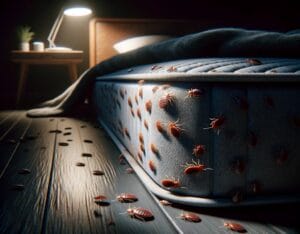
Bed bugs are less likely to infest a clean and clutter-free home because they have fewer places to hide. Regularly vacuuming your home, reducing clutter, and sealing cracks and crevices can deter bed bugs. Using protective covers for mattresses and box springs can also help prevent bed bugs from taking up residence in your bed.
Vigilant Travel Tips: Avoiding Unwanted Hitchhikers
Bed bugs are notorious for hitching rides on luggage, clothing, and other personal items. When traveling, consider reviewing effective prevention tips to keep these pests at bay.
- Inspect hotel room beds, furniture, and luggage stands for signs of bed bugs.
- Keep your luggage on a luggage rack, away from the bed and walls.
- When you return home, immediately wash all your clothes in hot water and vacuum your suitcase.
Being proactive during and after travel can greatly reduce the risk of inadvertently bringing bed bugs into your home.
Ensuring Victory: Follow-Up Inspections and Measures
After treatment, you’re not quite done yet. Ensuring the bed bugs are truly gone requires follow-up. Most professionals will return for a post-treatment inspection, but you can also do your part by regularly checking for signs of a resurgence. Pay special attention to your bedroom and any previously infested areas. Consistency is key to preventing another full-scale invasion.
Reclaiming Your Space: Cleaning and Organizing After Infestation
Once the bed bugs are gone, it’s time to clean up. Vacuum your home thoroughly and consider steam-cleaning carpets and furniture. Wash all bedding and clothing in hot water and dry on high heat. You may also want to declutter to reduce potential hiding spots for any future pests. Taking these steps not only helps to eliminate any lingering bugs or eggs but also gives you peace of mind.
Frequently Asked Questions
Let’s tackle some common questions about bed bugs to clear up any lingering doubts and ensure you’re armed with the knowledge you need to keep your home bed bug-free.
How can I tell if my bites are from bed bugs?
Bed bug bites often appear as red, itchy welts in a line or cluster. However, everyone reacts differently, and some people may not react at all. To be sure, you’ll need to look for additional evidence of bed bugs in your environment, not just rely on bite patterns.
Are there any home remedies effective against bed bugs?
While some home remedies may offer temporary relief, they are rarely effective at completely eradicating an infestation. Bed bugs are resilient, and over-the-counter sprays or DIY solutions may not reach the hidden bugs. Professional treatment is usually necessary for a lasting solution.
What steps should I take if I discover bed bugs in my hotel room?
If you find bed bugs in your hotel room, notify the management immediately and request a different room, preferably not adjacent to or directly above/below the infested room. When you return home, launder all your clothes in hot water and inspect your luggage carefully to ensure you’re not bringing any bugs home with you.
How often should I inspect my home for bed bugs?
Regular inspections can catch an infestation early, making it easier to deal with. It’s a good practice to inspect your home for bed bugs every few months or when you return from travel. Be especially vigilant if you’ve purchased second-hand furniture or had guests stay over.
